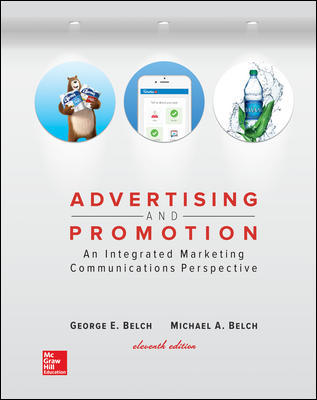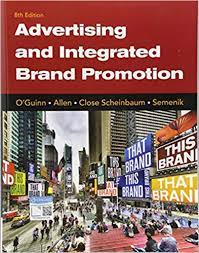Description
Test Bank For Advertising and Promotion An Integrated Marketing Communications Perspective 11Th Edition By George Belch
Chapter 02 Test Bank
Student: ___________________________________________________________________________
1. Market opportunities are areas where the company believes that customer needs and opportunities are being satisfied.
True False
2. A market can rarely be viewed as one large, homogeneous group of customers; rather, it consists of many heterogeneous groups, or segments.
True False
3. Dominating channels of distribution is one way of creating a competitive advantage.
True False
4. Marketers often go after the entire market with one product, brand, or service offering to create the maximum impact.
True False
5. In a typical target marketing process, the stage of segmenting the market is immediately followed by positioning one’s product or service through effective marketing strategies.
True False
6. Target market identification isolates consumers with similar lifestyles, needs, and the like, and increases the knowledge of their specific requirements.
True False
7. The more marketers segment the market, the less precise is their understanding of it.
True False
8. In the geographic segmentation approach, markets are divided into units based on consumers’ occupations and lifestyles.
True False
9. When a market is segmented based on personality, lifecycles, and/or lifestyles, it is referred to as demographic segmentation.
True False
10. The determination of lifestyles is usually based on an analysis of the activities, interests, and opinions (AIOs) of consumers.
True False
11. Segmenting the market based on consumers’ product or brand usage and the degree of use is an example of behavioristic segmentation.
True False
12. Industrial marketers refer to the 80–20 rule, meaning that 20 percent of their buyers account for 80 percent of their sales volume.
True False
13. Differentiated marketing is used when the firm selects one segment and attempts to capture a large share of this market.
True False
14. The positioning by competitor approach positions a product by associating it with a particular user or group of users.
True False
15. Premium brands positioned at the high end of the market usually use the price/quality approach to positioning.
True False
16. When positioning by product class, marketers only position against brands, and not against other product categories.
True False
17. Repositioning of a product usually occurs because of declining or stagnant sales.
True False
18. Strong symbolic features and social and psychological meaning may be more important than functional utility for many products.
True False
19. Brand equity refers to the tangible assets earned through a product’s functional purpose.
True False
20. A marketer with an integrated marketing communications (IMC) perspective is likely to link high relative ad expenditures with premium prices, and low relative ad expenditures with low prices.
True False
21. Trade advertising focuses on sales promotion efforts directed toward the ultimate consumer.
True False
22. Most consumer-product companies distribute through direct channels.
True False
23. According to the marketing and promotions process model, the marketing process begins with the
A. development of the brand equity.
B. development of a marketing strategy.
C. development of the promotional mix.
D. determination of the promotional budget.
E. establishment of a nano-campaign marketing strategy.
24. According to the marketing and promotions process model, in which of the following stages does the company decide the product or service areas and particular markets where it wants to compete?
A. development of a marketing strategy and analysis
B. development of the target marketing process
C. allocation of advertising budget
D. development of the marketing planning program
E. creation of a positioning strategy
25. The Manischewitz company broadened its marketing efforts to capture more of the mainstream market following a(n) ____________________________, which identified favorable demand trends for ethnic foods.
A. positioning strategy
B. opportunity analysis
C. budget analysis
D. promotional push strategy
E. promotional pull strategy
26. _____ is a detailed assessment of the current marketing conditions facing the company, its product lines, or its individual brands.
A. Matrix analysis
B. Micro analysis
C. Situation analysis
D. Opportunity analysis
E. Competitive analysis
27. When Coca-Cola wanted to regain market share for its vitaminwater product lines, it based its marketing strategy on a __________________, or a detailed assessment of the current marketing conditions facing the company, its product lines, and its individual brands.
A. matrix analysis
B. micro analysis
C. situation analysis
D. challenge analysis
E. competitive analysis
28. Which of the following is best defined as areas where there are favorable demand trends, customer needs and wants are not being satisfied, and where a company thinks it can compete effectively?
A. market segmentations
B. marketing channels
C. marketing stubs
D. market economics
E. market opportunities
29. A situational analysis
A. does not include an assessment of a company’s product lines.
B. usually starts with a positioning strategy.
C. does not include an assessment of the conditions facing the company.
D. typically involves creating branding strategies.
E. includes an assessment of a company’s individual brands.
30. During a routine market study conducted by CL Foods, it was noted that Chinese and Indian food products were in high demand in American society. In order to take advantage of such a demand, CL Foods manufactured and sold these food items locally. In this scenario, the company is taking advantage of a
A. market opportunity.
B. market aggregation.
C. market assimilation.
D. marketing buzz.
E. market threat.
31. FunZone Inc. identified and developed a SmartCard that can be used at fair grounds to make the ticketing process easier. The company found that the existing system was complicated and highly time-consuming. The SmartCard was easy to operate and each swipe would deduct the cost of a ride automatically. According to the given scenario, FunZone has recognized a
A. market opportunity.
B. marketing buzz.
C. marketing engagement.
D. marketing channel.
E. market threat.
32. There are several medicines that relieve allergy-related symptoms but only Sensitine comes in a quick dissolving form that can be easily swallowed without water. The manufacturer of Sensitine hopes the fact that it dissolves and enters the system more quickly than other brands will create a
A. market aggregation.
B. marketing assimilation.
C. competitive advantage.
D. cross-merchandising strategy.
E. market disintermediation.
33. ___________________ can be achieved through advertising that creates and maintains product differentiation and brand equity, as with the long-running advertising campaign for Michelin tires, which stressed security and performance.
A. Market aggregation
B. Marketing assimilation
C. Brand extensions
D. Competitive advantage
E. Market disintermediation
34. Offering quality products that command a premium price, providing superior customer service, having the lowest production costs and lower prices, or dominating channels of distribution are ways of
A. achieving a competitive advantage.
B. practicing cross-merchandising strategy.
C. creating market space.
D. practicing bait-and-switch marketing.
E. establishing a marketing stub.
35. _____ is defined as something unique or special a firm possesses or does that gives it an edge over other firms in a similar industry.
A. Competitor indexing
B. Switch marketing
C. Competitive advantage
D. Marketing stub
E. Bait-and-switch marketing
36. The strong brand images of Apple, Samsung, Nike, BMW, and McDonald’s give them a ___________________ in their respective markets.
A. competitive advantage
B. market opportunity
C. micro advantage
D. macro analysis
E. marketing challenge
37. John & Bauer Inc., manufacturers of health drugs, are the manufacturers of a painkiller called JB Revive. The painkiller is unique as it contains calcium, and it is quite unlike any other painkiller in the market. The addition of calcium led to an increase in sales of the medicine as well. In this scenario, the addition of calcium gives the company a
A. market engagement.
B. cross-merchandising opportunity.
C. competitive advantage.
D. marketing assimilation.
E. competitive index.
38. The first step in the target marketing process is to
A. develop positioning strategies.
B. request government approval.
C. determine whether to use a market segmentation strategy or a mass marketing strategy.
D. identify markets with unfulfilled needs.
E. develop new products.
39. The market segmentation process
A. divides a market into distinct groups that have heterogeneous needs.
B. divides a market into distinct groups that will respond similarly to marketing actions.
C. offers one version of the product to all markets.
D. creates products for several markets that have independent needs.
E. positions products in the minds of prospects and customers.
40. Directing a company’s efforts toward one or more groups of customers who share common needs is known as
A. cross-merchandising.
B. competitor indexing.
C. mass customization.
D. target marketing.
E. cross-branding.
41. ________________ is dividing a market into distinct groups that (1) have common needs, and (2) will respond similarly to a marketing action.
A. Market segmentation
B. Competitor indexing
C. Mass customization
D. Cross merchandising
E. Cross-branding
42. Dividing the market into units such as nations, states, counties, or even neighborhoods is known as
A. demographic segmentation.
B. psychographic segmentation.
C. quantified aggregation.
D. lifestyle aggregation.
E. geographic segmentation.
43. Which of the following is a geographic variable for segmentation of the market?
A. family size
B. occasions
C. counties
D. age
E. gender
44. Which of the following is a geographic segmentation variable?
A. income
B. neighborhood
C. sex
D. education
E. involvement
45. Delish Inc., a food manufacturer, introduced an instant soup specially designed for and advertised in the colder regions of Asia and Europe. This is an example of
A. demographic segmentation.
B. psychographic segmentation.
C. sociocultural segmentation.
D. geographic segmentation.
E. undifferentiated marketing.





Be the first to review “Test Bank For Advertising and Promotion An Integrated Marketing Communications Perspective 11Th Edition By George Belch”